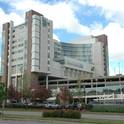Article
Beta-galactosidase-tagged adventitial myofibroblasts tracked to the neointima in healing rat vein grafts
Journal of Vascular Research
(2003)
Abstract
Abstract
OBJECTIVE:
Myofibroblasts are present transiently in normal healing wounds. However, they have been found to persist in the stroma of neoplasms, fibrotic conditions and other pathological settings. In rat vein grafts, we have observed the prolonged presence of myofibroblasts. Our aim was to determine the origin of myofibroblasts in vein grafts.
METHODS:
Epigastric vein to femoral artery grafts were microsurgically placed in male Lewis rats and harvested. Neointimal development, cellular death and proliferation, and cell phenotypes were analyzed using immunohistochemistry and light and electron microscopy. To follow cellular movement in the vessel wall, vein grafts were transfected with replication-defective adenovirus containing the gene encoding beta-galactosidase (n = 50), and harvested at 1, 2, 3, 4, 5, 6, 7, 14 and 28 days. Grafts were analyzed after X-gal staining.
RESULTS:
Myofibroblasts were detected in the outer adventitia at 4 days, in the media at 1 week and in the developing neointima at 2 weeks. Cells tagged using adenoviral beta-galactosidase demonstrated adventitia to neointima cell migration.
CONCLUSIONS:
Although there may be other sources of myofibroblasts in this model, the adventitia has been shown to be an origin of myofibroblasts which subsequently migrate through the vessel wall to the neointima during graft remodeling and contribute to neointimal formation.
Disciplines
Publication Date
2003
Citation Information
J. J. Tomas, V. E. Stark, Jimmy L. Kim, R. A. Wolff, et al.. "Beta-galactosidase-tagged adventitial myofibroblasts tracked to the neointima in healing rat vein grafts" Journal of Vascular Research Vol. 40 Iss. 3 (2003) p. 266 - 275 ISSN: 1018-1172 Available at: http://works.bepress.com/auroragastroenterology-faculty/7/
